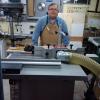I just saw this mobile base design (his video link for full details) on here and don't understand why it's not more popular. I'm not referring to the flip top, but the mobile aspect. Basically it's like turning the stand into a dolly. Two wheels in back that don't touch the ground when it's upright. To move it, tilt it back to balance it on the wheels then move it. What's the con that I'm missing in comparison to other mobile base designs? It seems to solve the biggest issue of getting 4 wheels to really lock and preventing movement when setup. Other designs that flip the wheels out of the way seem a tad more complicated to build (at least after looking at this). The only downside I see is that you need a little extra room to maneuver. I suppose there's also the off chance the whole thing could slip under itself since they would generally be top heavy. But literally... add two wheels and yer done! It seems too good to be true! Is it?




 Reply With Quote
Reply With Quote




